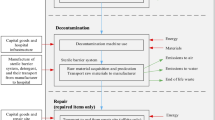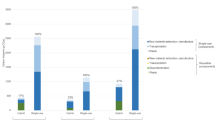Abstract
Purpose
In recent years, the rising costs and infection control lead to an increasing use of disposable surgical instruments in daily hospital practices. Environmental impacts have risen as a result across the life cycle of plastic or stainless steel disposables. Compared with the conventional reusable products, different qualities and quantities of disposable scissors have to be taken into account. An eco-efficiency analysis can shed some light for the potential contribution of those products towards a sustainable development.
Methods
Disposable scissors made of either stainless steel or fibre-reinforced plastic were compared with reusable stainless steel scissors for 4,500 use cycles of surgical scissors used in Germany. A screening life cycle assessment (LCA) and a life cycle costing were performed by following ISO 14040 procedure and total cost of ownership (TCO) from a customer perspective, respectively. Subsequently, their results were used to conduct an eco-efficiency analysis.
Results and discussion
The screening LCA showed a clear ranking regarding the environmental impacts of the three types of scissors. The impacts of the disposable steel product exceeds those of the two others by 80 % (disposable plastic scissors) and 99 % (reusable steel scissors), respectively. Differences in TCO were smaller, however, revealing significant economic advantages of the reusable stainless steel product under the constraints and assumptions of this case study. Accordingly, the reusable stainless steel product was revealed as the most eco-efficient choice. It was followed by the plastic scissors which turned out to be significantly more environmentally sound than the disposable stainless steel scissors but also more cost-intensive.
Conclusions
The overall results of the study prove to be robust against variations of critical parameters for the prescribed case study. The sensitivity analyses were also conducted for LCA and TCO results. LCA results are shown to be reliable throughout all assumptions and data uncertainties. TCO results are more dependent on the choice of case study parameters whereby the price of the disposable products can severely influence the comparison of the stainless steel and the plastic scissors. The costs related to the sterilisation of the reusable product are strongly case-specific and can reduce the economic benefit of the reusable scissors to zero. Differences in environmental and economic break-even analyses underline the comparatively high share of externalised environmental costs in the case of the disposable steel product.










Similar content being viewed by others
Abbreviations
- CED:
-
Cumulative energy demand
- E/E:
-
Eco-efficiency
- GRP:
-
Glass-reinforced plastics
- LCA:
-
Life cycle assessment
- LCIA:
-
Life cycle impact assessment
- LCI:
-
Life cycle inventory
- TCO:
-
Total cost of ownership
- WBCSD:
-
World business council for sustainable development
- WRE:
-
World ReCiPe midpoint
- WRM:
-
World ReCiPe endpoint
References
Adler S, Scherrer M, Rückauer KD, Daschner FD (2005) Comparison of economic and environmental impacts between disposable and reusable instruments for laparoscopic cholecystectomy. Surg Endosc 19:268–272
Aoe T (2007) Eco-efficiency and ecodesign in electrical and electronic products. J Clean Prod 15:1406–1414
Apelgre KN, Blank ML, Slomski CA, Hadjis NS (1994) Reusable instruments are more cost-effective than disposable instruments for laparoscopic holecystectomy. Surg Endosc 8:32–34
Baykasoglu A, Dereli T, Yilankirkan N (2009) Application of cost/benefit analysis for surgical gown and drape selection: a case study. Am J Infect Control 37:215–226
Belboom S, Renzoni R, Verjans B, Léonard A, Germain A (2011) A life cycle assessment of injectable drug primary packaging: comparing the traditional process in glass vials with the closed vial technology (polymer vials). Int J Life Cycle Assess 16:159–167
Blanchard BS (1978) Design and manage to life cycle cost. Virginia Polytechnic Institute and State University, Portland, M/A Press
Bribián IZ, Capilla AV, Usón AA (2011) Life cycle assessment of building materials: comparative analysis of energy and environmental impacts and evaluation of the eco-efficiency improvement potential. Build Environ 46(5):1133–1140
Campion N, Thiel CL, DeBlois J, Woods NC, Landis AE, Bilec MM (2012) Life cycle assessment perspectives on delivering an infant in the US. Sci Total Environ 425:191–198
Conrady J, Hillanbrand M, Myers S, Nussbaum G (2010) Reducing medical waste. AORN J 91:711–721
DIN EN 285:2009-08: Sterilization—steam sterilizers—large sterilizers. German version EN 285:2006+A2:2009
EHS Medizintechnik (2009) Aesculap SUSI-Eine Kosten-Nutzen-Analyse, http://www.ehs.de/home/fachdisziplinen-produkte/zentralsterilisation/aesculap-susi/susi-kosten-nutzen-analyse.html. Accessed 3 October 2012
Environmental Protection Agency (2002) European waste catalogue and hazardous waste list. Valid from 1 January 2002, ISBN: 1-84095-083-8, Ireland
Frischknecht R, Jungbluth N, Althaus H-J, Doka G, Dones R, Hischier R, Hellweg S, Nemecek T, Rebiter G, Spielmann M (2007) Overview and methodology. Final report Ecoinvent data v2.0 No.1. Swiss Centre for Life Cycle Inventories, Duebendorf, Switzerland
Gilden DJ, Scissors KN, Reuler JB (1992) Disposable products in the hospital waste stream. West J Med 156:269–272
Goedkoop M, Heijungs R, Huijbregts M, Schryver AD, Struijs J, Van Zelm R (2009) ReCiPe 2008. A life cycle impact assessment method which comprises harmonised category indicators at the midpoint and the endpoint level. VROM, The Hague
Herrmann C (2010) Ganzheitliches Life-Cycle-Management-Nachhaltigkeit und Lebenszyklusorientierung in Unternehmen. Springer, Berlin
International Energy Agency (2010a) Electricity/heat in 2010. www.iea.org/stats/index.asp. Accessed 4 September 2012
International Energy Agency (2010b) CO2 emissions from fuel combustion highlights, 2010th edn. IEA, Paris
ISO 14040 (2006) Environmental management—life cycle assessment—principles and framework. ISO, Geneva
Jones CI, McManus MC (2010) Life-cycle assessment of 11 kV electrical overhead lines and underground cables. J Clean Prod 18:1464–1477
Kerr W, Ryan C (2001) Eco-efficiency gains from remanufacturing: a case study of photocopier remanufacturing at Fuji Xerox Australia. J Clean Prod 9(1):75–81
Klar M, Haberstroh J, Timme S, Fritzsch G, Gitsch G, Denschlag D (2011) Comparison of a reusable with a disposable vessel-sealing device in a sheep model: efficacy and costs. Fertil Steril 95:795–798
Kummerer K, Dettenkofer M, Scherrer M (1996) Comparison of reusable and disposable laparotomy pads. Int J Life Cycle Assess 1:67–73
Laustsen G (2007) Reduce–recycle–reuse: guidelines for promoting perioperative waste management. AORN J 85(4):717–728
Lyrstedt F (2005) Measuring eco-efficiency by a LCC/LCA ratio an evaluation of its applicability A case study at ABB. MSc. Thesis, Chalmers University of Technology
McGain F, McAlister S, McGavin A, Story D (2010) The financial and environmental costs of reusable and single-use plastic anaesthetic drug trays. Anaesth Intensive Care 38:538–544
Mercateo (2012) Chirurgische schere bei mercateo online kaufen. Mercateo Deutschland, http://www.mercateo.com/kw/chirurgische%2820%29schere/chirurgische_schere.html. Accessed 28 September 2012
Michelsen O, Fet AM, Dahlsrud A (2006) Eco-efficiency in extended supply chains: a case study of furniture production. J Environ Manag 79:290–297
Morrison JE, Jacobs VR (2004) Replacement of expensive, disposable instruments with old-fashioned surgical techniques for improved cost-effectiveness in laparoscopic hysterectomy. JSLS 8:201–206
Oikawa S, Ebisu K, Fuse K (2005) Fujitsu’s approach for eco-efficiency factor. Fujitsu Sci Tech J 41(2):236–241
Overcash M (2012) A comparison of reusable and disposable perioperative textiles: sustainability state-of-the-art. Anesth Analg 114(5):1055–1066
Park PJ, Tahara K (2008) Quantifying producer and consumer-based eco-efficiencies for the identification of key ecodesign issues. J Clean Prod 16:95–104
PRe Consultants BV (2008) SimaPro 7 user’s manual. The Netherlands
Rattanapana C, Suksaroj TT, Ounsaneha W (2012) Development of eco-efficiency indicators for rubber glove product by material flow analysis. Procedia - Social Behav Sci 40:99–106
Recipe, introduction (2011) http://sites.google.com/site/lciarecipe/project-definition. Accessed 4 September 2012
Saling P, Kircherer A, Dittrich-Krämer B, Wittlinger R, Zombik W, Schmidt I, Schrott W, Schmidt S (2002) Eco-efficiency analysis by BASF: the method. Int J Life Cycle Assess 7(4):203–218
Schooleman S (1993) OR industry split on merits of disposable/reusable instruments. Health Ind Today 56(5):1
Schubert K (2009) Abfallmanagement an einem krankenhaus mit maximalversorgung - ein praxisbericht. presentation at 5. Umwelttag NRW – Bochum 15.09.2009, http://www.ak-umwelt-im-krankenhaus.de/unterlagen/umwelttag/2009/Vortragsunterlagen/WS%204_5%20schubert%20Vortrag%20Bochum%2015092009.pdf. Accessed 28 September 2012
Schulz J, Pschorn J, Kara S, Herrmann C, Ibbotson S, Dettmer T, Luger T (2011) Environmental footprint of single-use surgical instruments in comparison with multi-use surgical instruments. 18th CIRP Conference on Life Cycle Engineering, Braunschweig, Germany, pp 623–628
Silalertruksa T, Sébastien Bonnet S, Gheewala SH (2012) Life cycle costing and externalities of palm oil biodiesel in Thailand. J Clean Prod 28:225–232
Sisolefyky J (2012) Written communication. Vanguard Integrierte Verorgungssysteme GmbH, Accessed 28 August 2012
van Middelaar CE, Berentsen PBM, Dolman MA, de Boer IJM (2011) Eco-efficiency in the production chain of Dutch semi-hard cheese. Livest Sci 139:91–99
Vercalsteren A, Spirinckx C, Geerken T (2010) Life cycle assessment and eco-efficiency analysis of drinking cups used at public events. Int J Life Cycle Assess 15:221–230
WBCSD (2000) Eco-efficiency—creating more value with less impact, ISBN 2-940240-17-5, http://www.wbcsd.org/web/publications/eco_efficiency_creating_more_value.pdf. Accessed 28 September 2012
Wübbenhorst K (1984) Konzept der lebenszykluskosten. Grundlagen, Problemstellungen und technologische Zusammenhänge. Verlag für Fachliteratur Darmstadt, Darmstadt, Germany
Acknowledgments
The authors especially thank Jörg Sisolefsky (Vanguard Integrierte Verorgungssysteme GmbH) for his contribution to this study.
Author information
Authors and Affiliations
Corresponding author
Additional information
Responsible editor: Marzia Traverso
Rights and permissions
About this article
Cite this article
Ibbotson, S., Dettmer, T., Kara, S. et al. Eco-efficiency of disposable and reusable surgical instruments—a scissors case. Int J Life Cycle Assess 18, 1137–1148 (2013). https://doi.org/10.1007/s11367-013-0547-7
Received:
Accepted:
Published:
Issue Date:
DOI: https://doi.org/10.1007/s11367-013-0547-7




